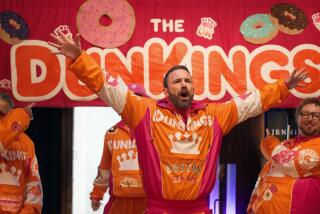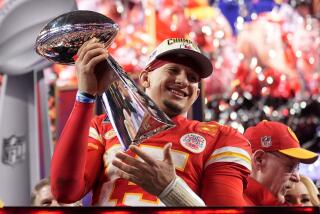How Does Brady Do It?
One thing about New England’s Tom Brady that makes him a candidate for best active quarterback is that he plays successful NFL football without a cast of great pass receivers.
As the Chicago Bears will see Sunday, the only first-class receiver in the Patriot lineup, Troy Brown, moves around on an injured leg.
In the other pass-catching positions, the Patriots are too slow, too inexperienced, or too deficient in NFL talent.
Yet in Week 8, Brady passed for 310 yards, completing 23 of 27, to beat former teammate Drew Bledsoe in Buffalo, 38-7.
On the game’s decisive plays, when none of Brady’s wide receivers could break into the open, he threw the ball to some of his backs instead, or to tight ends. In these circumstances, it was the game of the year for a passer in this league.
Belichick Keeps Passer Passing
FOR THE PATRIOT coach, Bill Belichick, the Buffalo game was a coaching masterpiece. He won because he kept Brady at it. He kept him throwing the ball because of his faith that Brady could find somebody open. Along with everybody else, Belichick could see that New England’s wide receivers were mired in the Buffalo defense. But last year, Belichick had handpicked Brady over Bledsoe, and he knows he was right about that. Secondly, Belichick won because he knows defensive football so well. In a must-win game, this is the guy you want in charge of your defense.
The Patriots, however, might not have enough pass-receiving class to repeat as Super Bowl champions. Their problems were best illustrated whenever flanker Brown was running a crossing pattern. Typically, when throwing to Brown on such a play, Brady threw the ball too far in front of him. In other words, he remembered Brown’s old pre-injury speed and couldn’t adjust. Few passers have ever been able to adjust in such a predicament. The right timing with a good receiver is hard enough to get in the first place. To disremember all that is beyond human. Even so, Brady continues to stand out.
Bledsoe’s Receivers Much Better than Brady’s
THE DIFFERENCE IN class between New England’s receivers and Buffalo’s resembles the difference between college and pro ball. On the Buffalo team, Bledsoe can choose between wide receivers who have been the two most productive in the league for most of the last two months.
They are split end Eric Moulds, who compares with any receiver in football except San Francisco’s Terrell Owens, and flanker Peerless Price. Moreover, fullback Larry Centers, who plays a key role in Buffalo’s pass-pattern network, compares with any pass-catching fullback in football.
Bledsoe, in other words, had a large advantage over Brady in downfield help. Despite Bledsoe’s excellence as a passer, his fast start in Buffalo this season has been in large part attributable to the excellence he found there in the receiving positions — to his obvious surprise — following the mediocrity he had put up with in New England while losing his job to Brady.
Football fans and critics measuring one passer against another these days — as everyone does on talk shows and in print — are prone to overlook the differences in supporting casts that quarterbacks all have. Thus, one of Hall of Famer Joe Montana’s assets was Jerry Rice, who at age 40 is still better than most of his peers. One of quarterback Peyton Manning’s assets is the smooth Indianapolis wide receiver, Marvin Harrison. And so on.
Brady had a guy like that last year, Troy Brown, but he doesn’t really have him now. In the passer ratings, Brady rates quite a few extra points because of whom he has to throw to.
Running Backs’ Support Counts Also
IN RUNNING-BACK comparisons as well, football’s fans and critics might give more weight to the differences in supporting casts. In San Francisco, for example, the alternating featured backs, Garrison Hearst and Kevan Barlow, good as they are, benefit hugely from the excellence of teammates Jeff Garcia, the quarterback, and Owens.
Theirs is an excellence of an order that is completely unknown to, for example, Cincinnati running back Corey Dillon. As Dillon again averaged over 4 yards in 22 Week 8 carries, the Bengals finally won their first game of the season, smacking expansion Houston, 38-3.
For the last four or five years, considering the lack of overall quality in the Cincinnati organization, Dillon probably should have ranked as the NFL’s No. 1 active running back.
Of the many reasons I continue to rate Hall of Famer O.J. Simpson as No. 1 all-time at that position, one explanation is the way he rose above his mediocre supporting cast in Buffalo. Drafted first by the worst pro club of its day, Simpson twice rushed for 2,000 or more yards on a team that was otherwise bereft of first-class quality at quarterback as well as at wide receiver and other positions and also on the coaching staff.
By comparison, Hall of Famer Jim Brown played for a Hall of Fame coach who was so able that his team, the Cleveland Browns, was named for him — for the man who was a veteran Ohio football idol, Coach Paul Brown — the only time such a thing ever happened in this sport.
Powerful running-back candidates for one-two all-time remain Simpson and Hall of Famer Walter Payton of Chicago, who until his old age as a Bear was stuck on bad teams that rose only occasionally to mediocrity.
Injury Ruins Nearly Every Runner
LONGEVITY IS A different kind of quality in ballcarriers. As every football fan knows, the top two all-time in running-back longevity are Payton and Emmitt Smith of the Dallas Cowboys. Thus, unsurprisingly, Smith and Payton are one-two in all-time yards gained. Most other NFL runners — even the finest of the others — have burned out or been invalided out after an average three or four seasons.
So there have always been and still are two categories of greatness at this position — those who burn gloriously for awhile before breaking up and those who last gloriously.
Among today’s running backs who have at times resembled the best you can name all-time — except lately — four are Eddie George of Tennessee, Edgerrin James of Indianapolis, Stephen Davis of Washington, and, of course, the recently-retired Terrell Davis of Denver.
It was injuries that brought them all down prematurely — them and nearly all other great ballcarriers in the many decades of NFL combat. Like quarterbacks, ballcarriers are marked targets for the defensive hitters who manage to knock most of them out. And only rarely does any injured great back come all the way back. Instead, when one does return, he typically plays awhile at reduced speed on the instincts that made him what he was, then fades away.
One exception in the modern NFL is San Francisco’s Hearst, who after a serious leg injury missed a season but who at the cost of long, painful rehabilitation has returned to pre-injury form.
More usual is Hall of Famer Gale Sayers, the short-lived (more exactly short-careered) all-pro who is often ranked with Jim Brown and O.J. Simpson in the all-time top three though he couldn’t regain pre-injury form. With reason, some have called their position the saddest bastion in football.
The Amazing Marshall Faulk
THE RAM STAR, Marshall Faulk, is still another kind of running back, one who could more accurately be referred to as a ball-advancer than ballcarrier. On either ground plays or pass plays, Faulk has shown more ways of moving his club forward than perhaps any other running back since the NFL began.
The 3-5 Rams therefore, after an 0-5 start, could get back into the playoff race this year if only they were in a different division. Their problem is that division-rival San Francisco (6-2) is in the season’s handful of big winners in a 32-team league that boasts no fewer than 22 teams with, already, four or more defeats.
In an offense that presents a constant twin threat with passer Marc Bulger and runner Faulk, the Faulk style is unique. As his team won again in Week 8, outscoring division-rival Arizona, 27-14, Faulk advanced the Rams 278 yards on rushes and catches that showcased him once more as the most amazing running back of his time, perhaps of any time.
What he did to Arizona was exactly what every situation called for whenever he had the ball. When necessary, for example, Faulk again advanced the Rams while running closer to his blockers than any peer — close enough sometimes to be in their hip pocket, if they had one.
Or, when a quick-opening play was there, he again accelerated with more speed and better instincts than any other active running back. Or, after a catch, he did the same.
Faulk’s ability to make timely, often-full-speed cuts is also unparalleled today and reminiscent of only two or three others before his time, among them Sayers and Simpson. If he isn’t quite in their class, it’s only because the game has changed so much in the last 60 years.
Put the Simpson of the 1970s in a good, modern pass-first offense and there would be numerous times when he wouldn’t be caught. Quicker than Jim Brown and also faster, Simpson, a college sprinter, would excel in a modern dump-pass attack of a kind he never saw — or as a counter-threat runner to the kind of great modern passer he never played with. In all-around terms, though, Faulk, since Simpson’s day, is the most exciting back football has had. And the most amazing.
Five More Picks
FIVE GUESSES on the five big games of Week 9:
San Francisco to win by 2 or 3 points over Kansas City at Arrowhead Stadium: As good as the Chiefs have become, they’re still a year away from beating teams like this.
Miami by 6 over the New York Jets at Pro Player Stadium: The Jets, 2-0 in their last two, are improving, but not yet by enough to overcome the Dolphin defense.
St. Louis by 7 over San Diego at the Edward Jones Dome: The Chargers will penetrate the Ram defense, and I won’t be surprised if they win, but a Ram defeat would be more surprising.
New England by 7 over Chicago in Urbana-Champaign on the field that made Red Grange famous: Offensive play selection will as usual undo a Bear team that is regaining form defensively.
Denver by 7 over Oakland on Monday night at Mile High Stadium: This one might not be easy for the Broncos, but they do seem to be hitting playoff stride.
More to Read
Go beyond the scoreboard
Get the latest on L.A.'s teams in the daily Sports Report newsletter.
You may occasionally receive promotional content from the Los Angeles Times.










